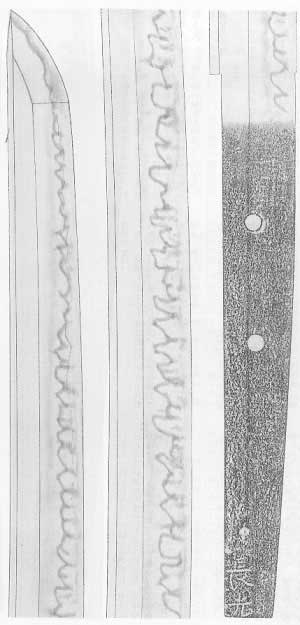NYUSATSU-KANTEI-TO OF THE 41ST ANNUAL CONVENTION
No.3 Tachi
| Mei: | “NAGAMITSU” |
| Ha-watari: | 67.7 cm |
| Sori: | 2.12 cm |
| Shinogi-zukuri | |
| Iori-mune | |
| Jihada: |
Itame-hada
combined with mokume and sporadic nagare-hada in company with fine
ji-nie then stands out on the whole then bo-utsuri appears along
by the hamon in the lower part and clear midare-utsuri in the upper
part.
|
|
| Hamon: |
Gunome-midare
mixed with choji, slightly pointed –midare, choji with flat head
and choji with round head. The hamon becomes narrow in the monouchi
area and is tempered in calm gunome pattern then many ashi, yo,
fine sunagashi and kinsuji are seen inside the hamon. It consists
of nioi accompanied with ko-nie and the nioi-guchi is bright.
|
|
| Boshi: |
Midare-komi
then turns back in ko-maru but it looks like yaki-tsume.
|
The blade has a little wide mi-haba, koshi-zori (even after suriage) and proper sori in the monouchi area so that it is attributed to one of the mid or late Kamakura period. Taking into account the clear midare-utsuri, it can be narrowed down to Bizen smiths. Among them, smiths who produce such clear midare-utsuri are the ones of the Ichimonji school, Mitsutada and Nagamitsu of the Ko-osafune school and Moriie of the Hatakeda school.
Taking a close look at the hamon, it is tempered in irregular width and mixes many gunome then the pattern becomes calm in the monouchi area. Thus, the Ichimonji school is excluded then Mitsutada, Nagamitsu and Moriie become smiths whom you have to give consideration.
All of them demonstrate a similar workmanship. Moriie tempers many and kawazuko-choji and his utsuri forms a pattern of kawazuko-choji too. Mitsutada’s extant works with signature have a resemblance to this tachi but choji is more emphasized and few togari-ba are seen in his hamon. Also his work could be mistake for Yamashiro swords at a glace since considerable nie are seen inside the hamon.
It is very rare to see hamon of Nagamitsu based on choji and kawazuko-choji. He normally tempers choji with round head and it mixes gunome and togari-ba then continuous gunome is tempered in small pattern in the monouchi area. His boshi becomes midare-komi with ko-maru or pointed tip when he tempers gorgeous hamon.
Yoshifusa and Sukezane of the Fukuoka-ichimonji school forge visible jihada and they temper choji mixed with o-choji and fukuro-choji in irregular width. Sukezane makes grand tachi-sugata and tempers the most gorgeous hamon in the school. The Yoshioka-ichimonji school tempers choji and the pattern tends to be slant on the whole.
Kagemitsu and Chikakage of the Ko-osafune school hardly temper gorgeous choji-midare. Their hamon are based on gunome then mix squarish gunome and kata-ochi-gunome then the pattern tends to be slant on the whole and many ashi are seen inside the hamon. Kagemitsu’s boshi is gentle notare with ko-maru, which is so-called ‘sansaku-boshi’.
Chikakage’s jihada stands out and his boshi goes straight across the yokote line then becomes gentle notare and turns back in circle.
